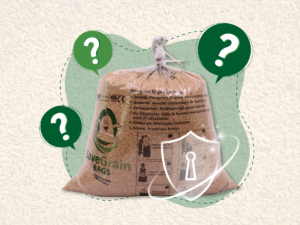Grains are a staple part of diets, especially in India, but are produced only during specific seasons. Thus, the right methods of food storage become a critical part of the production and distribution phase. Worldwide production of wheat, maize, rice, millet and sorghum is stored for months together, leading up to one to two years, depending on demand.
That is why using the correct methods of food storage are key. It normalizes fluctuations in the economy, and helps meet demand and supply patterns equitably. In the current environment, it is important to ensure that business activities are green and sustainable.
The growing need for appropriate grain storage in India
World Bank Reports have mentioned how post harvest loss in the country amounts to 12 to 16 million metric tons of food grains, per year. This could feed one-third of the country’s poor. Losses accrue to INR 7,000 crores every year due to grain storage difficulties.
Let’s take a look at the prevalent grain storage mechanisms.
Current Grain Storage Mechanisms
Aerial Storage
Sorghum, millet panicles and maize cobs are tied up in bundles and suspended from branches of trees, tight ropes, posts, or inside homes. This is obviously not efficient enough to store rather small or large harvest quantities. It does not protect the grains against unfavorable weather conditions such as extreme rain and heat. Adequate protection against rodents and insects is not available either. That’s why farmers end up spraying pesticide in the bundles which is not a healthy practice. Pesticides negatively affect consumers.
Silo Storage

Farmers, governments and businesses use this method for long term storage. Silos store a large bulk of commodities such as grains, cement, coal, and other such products. Modern upright silo storage began in the 1870s, and has grown in popularity since then. Commonly used variations include vertical stand-alone silos, bunker silos, trench silos and open-top silos.
The downside of this method of grain storage is that these silos need high maintenance in order to be effective. They can easily be subject to misuse or deterioration. Not immune to collapse, explosions and corrosion, silos can also cause serious damage to their surroundings.
Another downside to storing grains in silos is the tremendous pesticide requirement. Pesticides contaminate grains and affect a grain’s nutritional content.
Agricultural Warehousing

Warehousing is a popular technique in India. Specially designed to maintain the quality and quantity of grains, warehouses prevent an excess of sunlight, wind and moisture from coming in contact with the grains.
However, warehouse moths and beetles are a serious issue. Since grains are stored in jute bags, pesticides are sprayed on the fabric to stop the moths from penetrating these sacks. However this spray treatment is not as effective when it comes to treating beetles that can penetrate deep into the layers. While this build up of pesticide is not healthy for the grains and therefore consumers, it also leads to an increase in the pests’ resistance to such pesticides.
Hermetic Alternatives
Considering that the prevalent methods of storing grains we just discussed have proved to have several drawbacks that are nearly impossible to work around, exercising our choice towards a healthier, more efficient and green alternative is essential.
This takes us back to the grass-root movement. The world has witnessed people and businesses going back to simple, hermetic techniques and lifestyles. Be it with recyclable clothing, organic food consumption and organic farming with recycling of the remnants – and even recyclable storage bags.
Changing the methods of food storage to greener options is key.
SaveGrain Bags has kept this in mind and specially developed recyclable bags which employ hermetic storage techniques in order to store grains. Unlike the prevalent techniques, these bags eliminate the use of pesticide and provide healthier grains to the masses. Capable of storing grains for up to 2 years, these hermetic storage bags are recyclable due to their strength and quality.

Make a healthier switch – for your grains, for yourself and the world, today!





